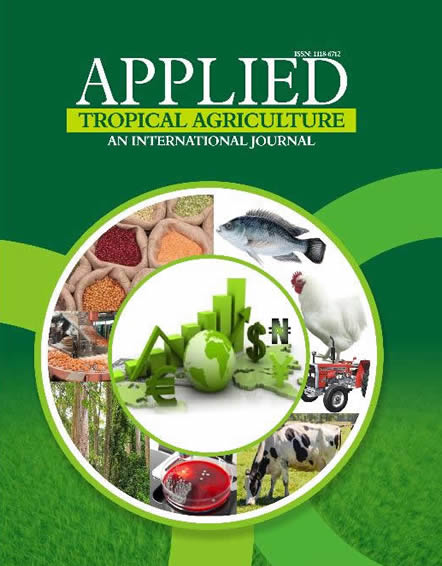Greenhouse and field experiments were conducted at the Department of Agronomy, University of Ibadan, Nigeria to
investigate the effects of arbuscular mycorrhiza (AM), mineral (NPK) and organomineral (OMF) fertilizers on the
growth and fruiting of pepper (Capsicum frutescens L.) on an alfisol. It was factorial experiments with two levels of
AM (with and without AM application); two levels of OMF pacesetter Grade – A (0and 2.5 t/ha) and three levels of
NPK (15-15-15) rates (0, 300 and 600 kg/ha) replicated three times. Highest plant height (39.0cm) was observed at
9th weeks after transplanting (WAT) from NPK fertilizer treatment applied at 300 kg ha-1 with AM inoculation and no
OMF application under greenhouse conditions. Combinations of both OMF and NPK at 2.5 t/ha and 300 kg/ha rates
respectively with AM inoculation significantly increased the height of pepper under field experiment. Effectiveness of
AM fungus with combined applications of OMF (2.5 t/ha) and NPK (300 kg/ha) fertilizers produced four times higher
number of leaves as well as AM with NPK (300 kg/ha) but without OMF applications compared to the control where
no treatment was applied under field and greenhouse experiments respectively. Number of branches and stem girth
was also significantly increased from combined applications of AM, NPK with and without OMF fertilizers under
field and greenhouse conditions respectively. Highest fresh fruit (81.0 g/plant) was obtained from NPK (300 kg/ha)
with AM fungus applications under greenhouse conditions while the highest fresh fruit yield of 76.0 g/plant was
obtained from OMF (2.5 t/ha) and NPK (300 kg/ha) with AM application under field conditions. The results showed
that combined applications of NPK with OMF and AM inoculation synergistically enhanced pepper yield. Possibility
of using a reduced rate of 300 kg ha-1 NPK along with other treatments can be beneficial to farmers.
PAPER TITLE :GROWTH AND FRUIT YIELD OF PEPPER (CAPSICUM FRUTESCENS L.) AS INFLUENCED BY ARBUSCULAR MYCORRHIZAL (A
APPLIED TROPICAL AGRICULTURE | VOLUME 15 NUMBER 1 2010
Paper Details
- Author(s) : S.A. ONI AND O. FAGBOLA
- Abstract:


